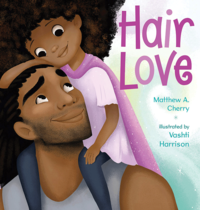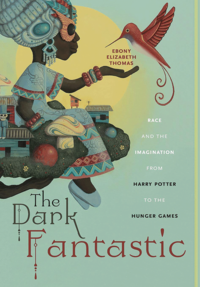
When Julián spots three mermaids on the subway home, he is in awe. He knows that he is a mermaid too—but he’s not sure what his abuela will think when he dresses up like one. A magical story written and illustrated by Jessica Love, Julián Is a Mermaid provides children the opportunity to see how important it is to express who you truly are—and how wonderful it is when the people you love encourage you to accept yourself.
ELEMENTARY SCHOOL
Warmth and love radiate from this colorful story of self-acceptance.
— Anya Malley

Hair Love teaches self-love and exemplifies representation for Black people and Black culture. Matthew A. Cherry’s book follows a little girl named Zuri as she works with her father to create a perfectly coifed hairstyle. In a time when Black youth are penalized for wearing their natural hair, this story shows an appreciation for the magic of grooming coarse or kinky hair, represented by Afros, locs, braids and a head wrap. The tenderness of Black fatherhood is also on display, offering plenty of heartwarming moments.
ELEMENTARY SCHOOL
A push against attempts to disparage those who dare to take pride in the way they look.
— Coshandra Dillard

In a box of puzzles in the attic, Candice discovers a letter addressed to her grandmother. This letter answers one of her big questions—why her grandmother left town in shame—but new questions arise. Pooling their resources of deduction and book smarts, Candice and her neighbor Brandon resolve to find answers. In The Parker Inheritance, Varian Johnson’s young protagonists embark on a mystery that will force their town to address its unjust past and the stain that segregation left behind.
MIDDLE SCHOOL
This clever puzzle stays with you as it presents a mystery to solve: What stories are still being hidden?
— Belle Briatico

In An Indigenous Peoples’ History of the United States: For Young People, Roxanne Dunbar-Ortiz provides for students historical examples that disrupt the dominant narrative and mythology surrounding the founding of the United States, which are too often still taught in classrooms. Written chronologically, An Indigenous Peoples’ History of the United States takes readers on an accurate journey of colonization, where the real thread is the complex nations and peoples who have resisted to this day.
MIDDLE AND HIGH SCHOOL
This book is a much-needed reminder that our complex and violent history can be taught to students in a way that is both accurate and age appropriate.
— Christina Noyes

One story is the perfect fit for a romantic comedy. Another one will have you on the edge of your seat, wondering if the main character will escape the grip of a terrifying ghost. All of the stories in Unbroken: 13 Stories Starring Disabled Teens, edited by Marieke Nijkamp, feature teens with disabilities as authentic central characters. Fully embodying their disabilities and personhood, they are the heroes and love interests, and, like all teens, they're learning how to harness their power. Note: Strong language and content advisory.
HIGH SCHOOL
Readers are long overdue for a text that moves disabled voices from the margins and into the center.
— Val Brown

“The opposite of ‘racist’ isn’t ‘not racist.’ It is ‘antiracist.’” This idea is the beating heart of Ibram X. Kendi’s How to Be an Antiracist: Our decisions, actions and thought processes can either maintain racist systems or actively work to dismantle them. Both challenging and accessible, Kendi's book weaves history, personal experiences and contextual analysis of policies to push readers to think critically about the role that race has played in society and their lived experiences. His perspective is a necessary addition to the conversation about how to make the world more equitable and just.
PROFESSIONAL DEVELOPMENT
This book is excellent for educators looking to engage in more nuanced conversations and deeper thinking around race.
— Jonathan Tobin

Jacob Tobia’s Sissy: A Coming-of-Gender Story follows the author throughout various stages in their education: elementary school, high school and college. Across the grade levels, Tobia illustrates the trauma caused by the strict enforcement of gender norms as well as the ways in which resistance and community take shape. Their memoir is an important read for providing genderqueer representation, which is still severely lacking in too many classroom and school libraries.
HIGH SCHOOL
A force of a book—equally educational as it is humorous, as personal as it is political.
— Henry Cody Miller, Teaching Tolerance Advisory Board member

In her 2016 Pushout, Dr. Monique M. Morris pushes readers to consider how educational settings perpetuate racial and gender hierarchies. In her 2019 follow up, Sing a Rhythm, Dance a Blues: Education for the Liberation of Black and Brown Girls, Morris puts forth a solutions-oriented approach to addressing how Black and Brown girls are impacted by school and disciplinary policies. Morris shares inspirational stories of educators across the country who are putting the needs and well-being of Black and Brown girls at the center so that readers may follow in their footsteps.
PROFESSIONAL DEVELOPMENT
In a time when Black and Brown girls are often overlooked in schools, Morris encourages us not only to support these girls but to lift them up and celebrate them for who they are.
— Rebecca Coven, Teaching Tolerance Advisory Board member

Elementary School
Don’t Touch My Hair
by Sharee Miller

Middle and High School
Some Places More Than Others
by Renée Watson

Professional Development
The Dark Fantastic: Race and the Imagination from Harry Potter to the Hunger Games
by Ebony Elizabeth Thomas